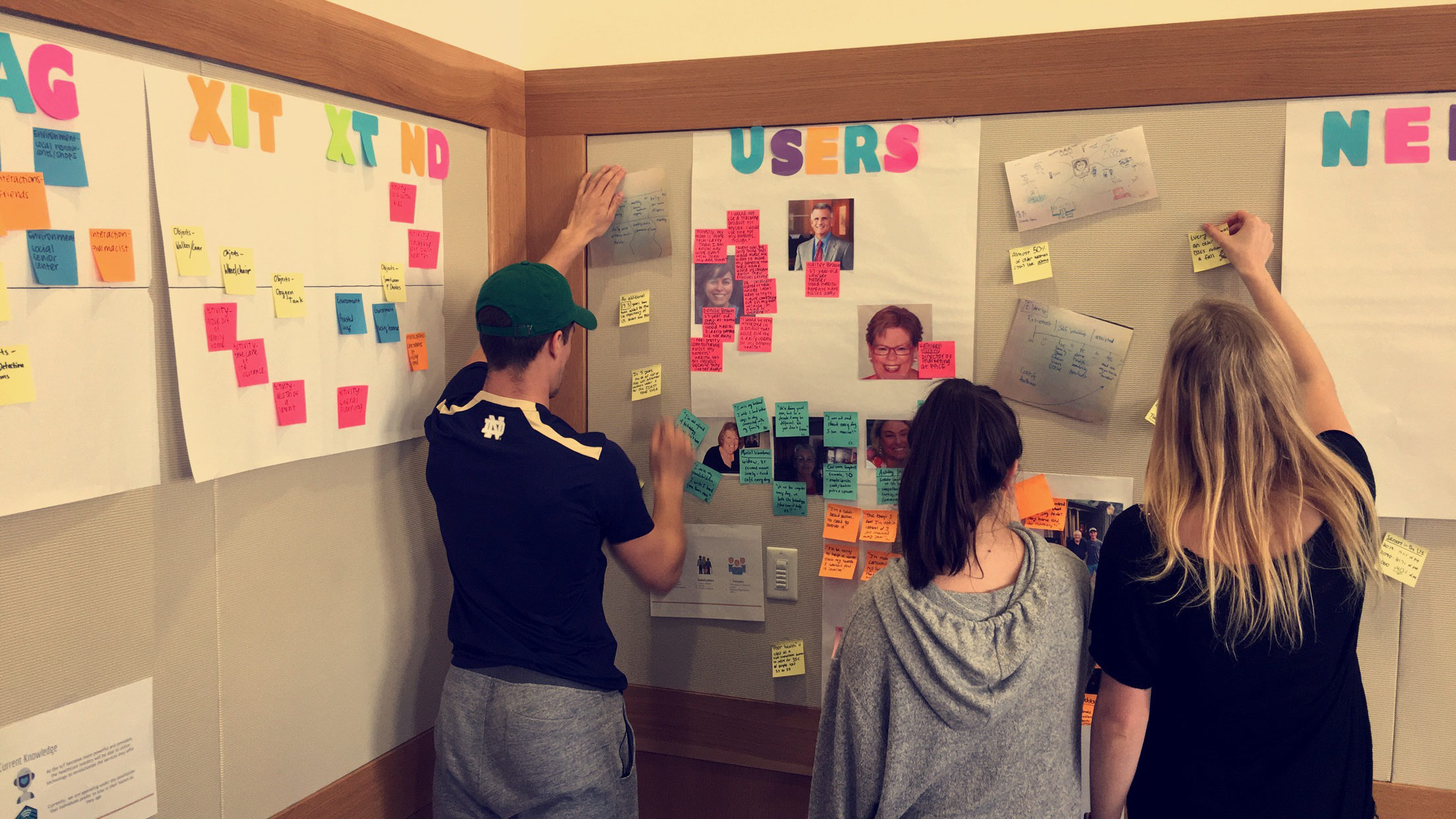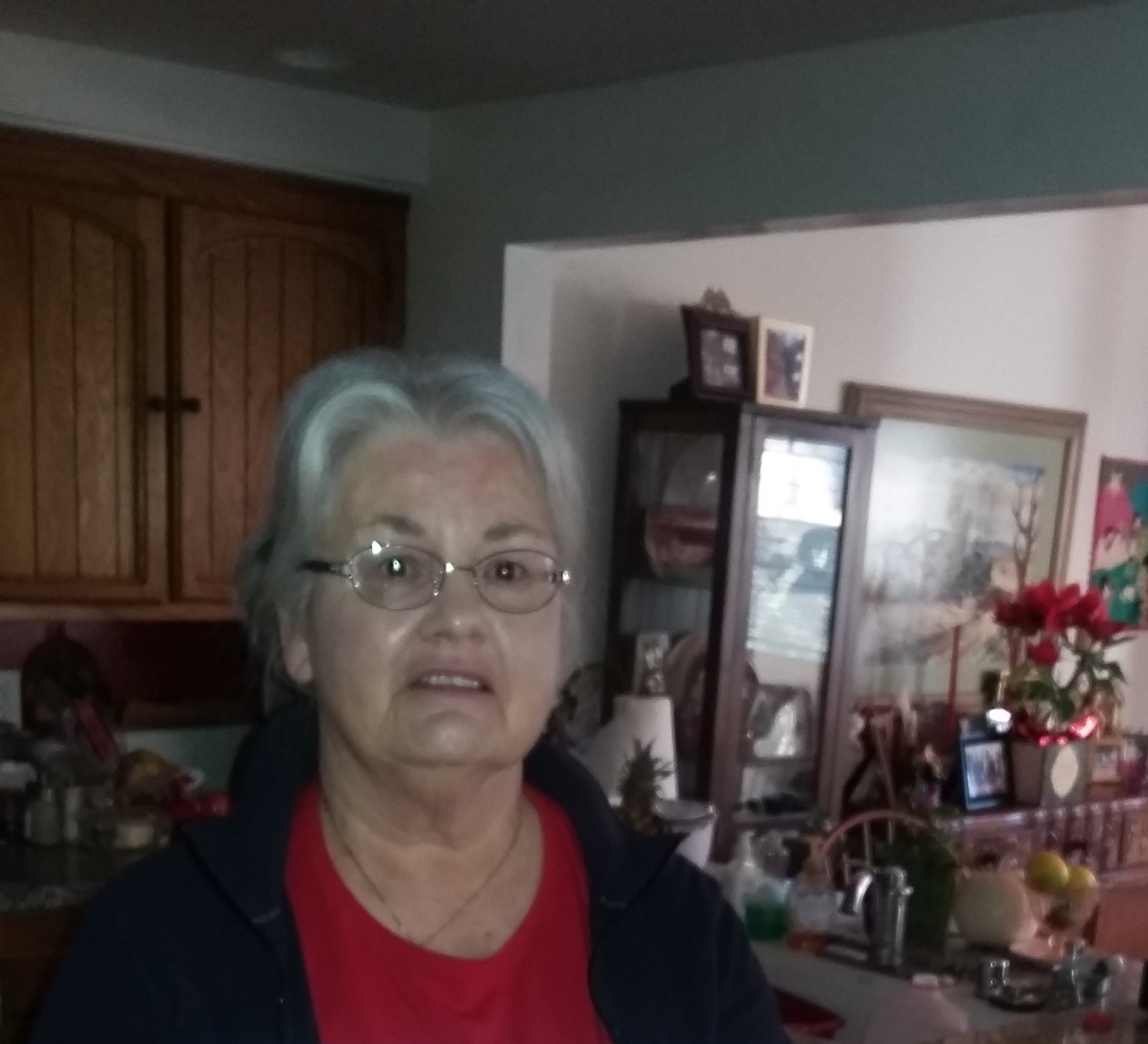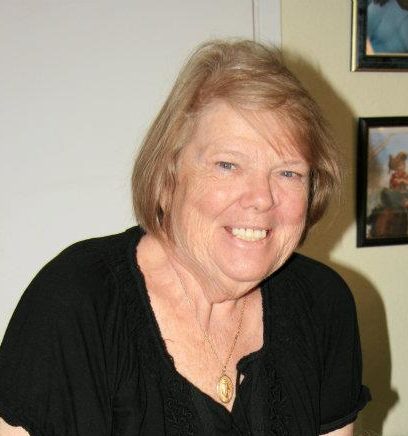Learn about Adam and his motivation for adopting the eVitalize ecosystem to be a better and more secure caregiver for his elderly parent.
Author: Rob
Workarounds
Here are a few workarounds noted over break.
The first is using a roommate’s tennis racket to help cook pasta.

The second is a fellow Phillies fan at a Spring Game we went to wearing a cardboard tray as a visor.

Gallery Day Setup, March 7th, 2017
Optum Team A is hard at work in the Stayer Center to set up for Gallery Day!
Interactive Ethnography: Card Sort
Two card sorts were conducted consecutively, to determine both the participants’ familiarity with technology and their concern for health. These are the two primary metrics by which our team has sorted our users, and this card sort helped to identify what was “normal” within those archetypes.
Curt and Carmen Campbell received the cards in their dining room.
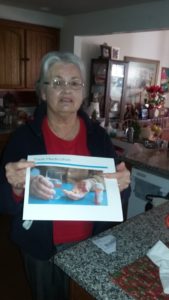
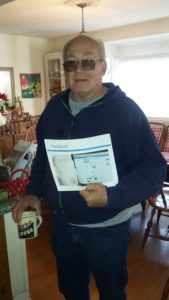
Next, they began to lay out the technology cards and sort them according to how familiar they are with the technology and how likely they would be to use it. Interestingly, Carmen laid hers out in the kitchen whereas Curt did his arranging on the dining table.
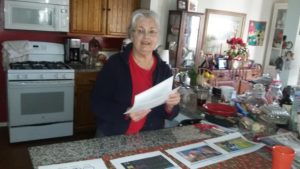
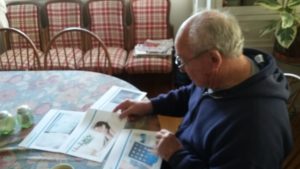
At the end of the technology sort, the results gave great insight into the archetypes of the participants. Carmen most preferred using a landline phone, with least preference towards using “FitBit” smartwear; whereas Curt most preferred the “FitBit” smartwear and least preferred using Facebook.
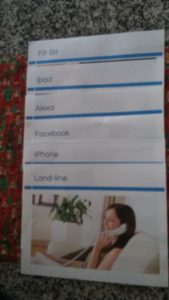
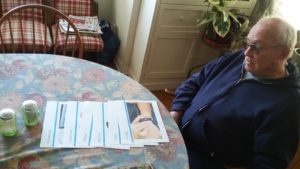
Next, Curt and Carmen sorted a deck containing health concerns which could be monitored by technology based on their priorities. In this case, Curt and Carmen had more similarity in their preferences. Carmen was most interested in tracking daily activity and exercise, while least interested in tracking her mood throughout the day. Curt found his vitals to be the most important, with his mood being the least important health concern.
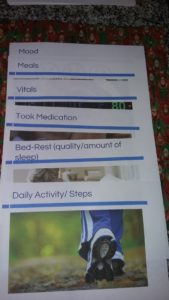
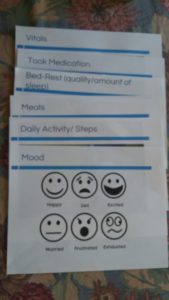
Overall, this exercise gave insight into what technologies can be leveraged to track which aspects of overall health of the elderly. A key takeaway is that each individual has different preferences, and a tailored care plan leveraging the most familiar technology with the most desired tracking results will be ideal.
Ethnography User Summary #2
This interview was conducted with Carmen Campbell, and contrasted the interview with Muriel Giambone significantly.
User Characteristics: “Active Arnold”
Grandmother, matriarch, community figure
Female, age 74
Garage sales, antique shopping, family oriented, mutual caretaking with spouse
What drives her?
Family, cooking, Catholicism, shopping and exploring antiques
What is her biggest point of pain?
Grandchildren moving away, making contact and communication less regular and common
Memorable Quotes:
“I am out and about almost every day, Curt and I walk regularly and like to see the neighbors”
“I’m interested in new technologies, Curt and I use the computer a lot to see the news and to talk to family”
“We’re both doing great now, but in the next decade things might become more difficult to maintain our lifestyle. I don’t know what will happen”
Top 3 Takeaways:
- Worried about family moving away from them, and having less communication.
- Very much involved in the community, feels rejuvenated by Church activities
- Casual interest in technology, but some devices are more approachable than others
Activities
- Morning breakfast with Curt, feed the cats, and have some early tea
- Neighborhood walk, say hi to friends in community
- Church activities such as catechumen meetings, HOPE Ministry meetings, prayer sessions
- Email correspondence with family every day, multiple per day
- Some television but not much, focus is on reading
Environment
- Kitchen, for cooking three full meals a day
- Garden, for growing vegetables and fruits to cook with
- Yard, for tending chickens and cats
- Living room, for checking and sending e-mail and watching television
Interactions
- Curt, husband, every day at home and most places together
- Elizabeth, daughter, nearly every day
- Sofia, granddaughter, nearly every day with Elizabeth
- Andru, grandson, most days (serves as a sort of guardian)
- Church members and ministers
Objects
- Computer and e-mail
- Television
- Books
- Focus on food and cooking
- Children and grandchildren
- Spouse
- Sisters (also elderly)
Ethnography User Summary
I conducted this interview with my grandmother, Muriel, to learn about her day-to-day life and how she could use technology to stay independent for as long as possible.
Ethnography Summary: User
February 26, 2017
Skype Video from Mission Viejo, CA
Conducted by Rob
User Characteristics: “Caretaker Carl”
Grandmother, matriarch, widow
Female, age 85
Constant care for spouse until 2016
Retired nurse, lonely recent widow
What drives her?
Family, celebrating events and achievements of children and grandchildren, community involvement
What is her biggest point of pain?
Lack of direction without husband, lack of direct family contact, growing discomfort with body as she ages
Memorable quotes:
“I miss Tom, but mostly I miss having the family around, I miss our big house and our big parties.”
“My grandchildren are everything to me, I want to see more of them”
“I’m not afraid of technology, but I don’t have the time to learn to use it”
Top 3 Takeaways:
- Interested in more communication with the family
- Relies on community for happiness and positivity: local coffee shop is crucial to daily routine
- Hates the idea of assisted living, saw sister go through that process and does not want it
Activities
- Morning walk to coffee shop
- Interactions with friends, baristas, other regulars at the café
- Afternoon lunch at home, call to one of her children to talk and hear updates
- Late afternoon television, gardening, preparing dinner
- Dinner often alone, with TV in living room
- Reading then early to bed
Environment
- Coffee shop is preferred comfort zone, quiet and familiar
- New apartment is small and cozy, but lonely and quiet
- Television, living room, kitchen are central focus of life
Interactions
- Coffee shop welcomes her happily, warmly, friendly ever day
- Knows her ‘regular’ order and just serves it to her at her favorite seat without asking
- She has friends and fellow elderly who relax and enjoy their mornings at the café
- Meets new people in the café and knows every employee by name
Objects
- Coffee cup, two to three per day
- Television is main source of company at home
Users
- Other independent elderly at the coffee shop
- Regular doctor visits, once per month
- Children and grandchildren, on average once a week
- Was spouse daily until he passed, as widow now much more lonely
Ethnographic Research: Expert Interview
March 3rd, 2017
St. Joseph PACE Center
Conducted with Mary Hinton
Expert Characteristics: “Dedicated Caretaker”
Ashley Stump
Female, 35-45, Intake Coordinator at PACE
Extremely empathetic and patient-oriented
What drives her?
Improving the lives of the elderly, focusing on making them “safe and healthy at home”
What is her biggest point of pain?
Not being able to do enough for those who are already in elderly car facilities.
Top 3 Takeaways:
- Elderly need a “one-stop shop” to deal with many complicated aspects of elder care
- Elderly need tailored, individual care plans and advocates who work for them
- Success is improved social integration, home independence and safety, less burden on family.
Key Insights: Transportation solutions are crucial to helping the elderly operate independently; the little tasks are what fall through the cracks (safety equipment in bathroom, picking up groceries, etc)
Activities:
- Greeting elderly as they enter by name
- Asking questions about their homes, families, lives
- Facilitating their care plan, through doctor appointments and therapy hours
- Main 3 activities she focuses on helping elderly with:
- Walking and transfers
- Bathroom Use
- Diagnosis and Complications Consideration
- Determines fit for PACE of elderly who come seeking help
- Wants more awareness of the center and its resources
Environment:
- St Joseph PACE Center
- Indoor, large one-story facility
- Doctor’s office/clinic
- Physical Therapy room
- Large dining room
- Kitchen with culinary lessons
- Chapel (nondenominational and all-welcoming)
- Morning to early afternoon (8am-3pm)
- PACE Center is comforting, warm colors, well-lit, spacious, clean
Interactions:
- Constantly communicating and socializing with the elderly
- Extremely empathetic and considerate, pure-of-heart
- Recounted her favorite success story with near-tears of happiness
Objects:
- Smart Casual outfit, style conscious
- Drinking coffee
Users:
- Independent Elderly
- Other experts
Memorable Quotes:
“We want to have a holistic and proactive approach; holistic in regards to the total care package, and proactive in regards to our efforts to assist those who go unnoticed”
“Our participants often can’t hear well, but I wish they had some way to communicate daily with their families”
“They often need regular and consistent ‘cueing’ in order to accomplish tasks, so it’s important that they have someone to assist them and remind them to do basic things like take their medicine”
Optum Design Brief
Design Brief
“With the aging of the US population, people will be happier and healthier in their homes versus care facilities. Are there ways of using the Internet of Things to better offer remote monitoring for caregivers, etc.? How do we help immediate post-retirees that are active and do not need a caregiver yet with prevention? For those that are working with a caregiver now, how do we keep them in the home longer?”
Project Description:
Discover a way to use the Internet of Things to monitor our aging population in their own homes and send any and all information to their doctors and/or caregivers.
Intent/Scope:
- Use the Internet of Things to create better, safer, lives for our aging population
- Provide caregivers and doctors with more frequent data on their family members/patients in order to catch concerning symptoms early
- Offer both freedom and safety to immediate post-retirees and active elders
Exploration Questions:
- What facets of at-home care can currently be improved upon?
- What role does emerging technology potentially play in this market?
- What are Optum’s current offerings?
Target Users:
- Early retirees and soon-to-retire seniors (ages 65-75) who are still active and able, maintain independence in living, and are or have been helping elderly parents through late-life care
Research Plan:
- Gather current statistics/information on the aging population and this demographic in the healthcare industry
- Talk to Pat Keran/other Optum employees about any current projects concerning IoT with aging people/caregivers
- Research current implementation of IoT in the healthcare industry
- Research caregiving strategy/use of technology with caregivers
- Interview potential stakeholders directly in order to diagnose current needs (think Competing Against Luck text)
Expected Outcomes:
- We are expecting to come up with an interactive way to bring aging patients closer to their caregivers and provide accurate information while allowing them to stay in their homes for longer.
Success Metrics:
- >60% satisfaction with IoT by elderly patients
- 2 organized activities per week utilizing IoT
Project Planning:
- Weekly team meetings to discuss strategy
- Biweekly communication with Contact
